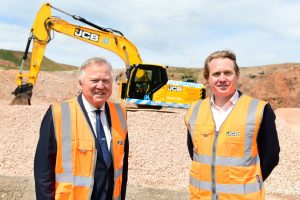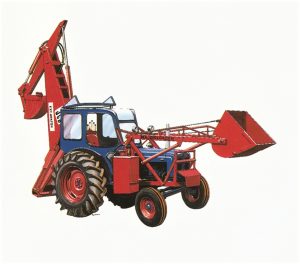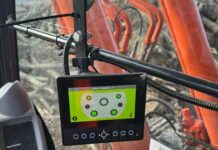To say that JCB has come a long way since it was founded 75 years ago is something of an understatement. Sometimes with a company so successful and solid, like its products, it is easy to lose sight of its original roots and its early pathway to global recognition.
Known and respected the world over, the company was established on October 23rd, 1945 by the late Joseph Cyril Bamford in a tiny lock-up garage in the Staffordshire market town of Uttoxeter.

Coincidentally, it was the same day as his son Anthony, now Lord Bamford, was born.
“Being presented with a son tended to concentrate the mind and when you were starting at the bottom, there was only one way to go and that was up,” JC Bamford is quoted as saying back then.
Looking back, that was a rather profound thing to say. The foundation for the growth that was to follow was the manufacture of a tipping trailer made out of war time scrap which today stands proudly in the showroom of JCB’s World HQ.
It was produced in his garage and sold for £45 at the town’s market. The buyer’s old cart was also taken in part exchange and Mr Bamford refurbished it and sold for another £45 – achieving the original asking price of the trailer.
By 1947 the company was expanding and because J C Bamford’s landlady also disapproved of his Sunday working, he moved a few miles down the road to a stable block at Crakemarsh Hall, which was owned by a Mrs Julia Cavendish, a survivor of the Titanic disaster. JCB also set on its first ever full-time employee, Arthur Harrison, who became foreman.
By 1950 JCB was on the move again, this time to the site of a former cheese factory in Rocester. The location had been identified by Bill Hirst, who revelled in the fact his workplace was now closer to home and enabled him to “spend an extra 10 minutes in bed.” Bill had joined JCB as a £1-a-week teaboy in 1947. He rose through the ranks to become Service Director.

1953 proved to be a pivotal year for new products when J C Bamford invented the backhoe loader with the launch of the JCB Mk 1 excavator. It was the first time a single machine had been produced with a hydraulic rear excavator and front mounted shovel.
This ingenuity still bears fruit today: JCB has manufactured more than 600,000 backhoes and they are now made on three continents.
1953 was also the year that the famous JCB logo – recognised the world over – was first used on a machine and it was eventually registered as a trademark five years later.
New Era Dawns
Between 1971 and 1973 turnover doubled to £40 million. In 1975 JCB’s Founder retired, telling staff in a farewell message: “Anthony faces the tough job of moving JCB forward through the next decades into a new century. This is a demanding task but he has been well trained for it and is supported by a very strong team from works staff to management. There cannot be any limit to the successes.”
And so a new era had dawned – and one that would see huge expansion of both manufacturing facilities and product ranges.
Fast forward to 2015 and JCB marked its 70th anniversary with a continued focus on product innovation as the wraps came off the brand new 3CX Compact backhoe loader, a machine 35 per cent smaller than its bigger brother and designed to work on increasingly congested building sites.
2016 was a year of milestones as the company celebrated the production of the 200,000th Loadall telescopic handler. It took almost 30 years for JCB to sell the first 100,000 Loadalls but it has taken less than 10 for the next 100,000 to be sold – testament to the growing importance of the product and JCB’s strength in this sector. Today JCB is the world’s number one producer of telescopic handlers. In this year JCB also marked the production on its 100,000th mini excavator and celebrated 25 years of production of the revolutionary Fastrac tractor. It was also the year when the new JCB Hydradig was launched to international acclaim.
Read the full story in the forthcoming print issue of Plant & Civil Engineer.

















